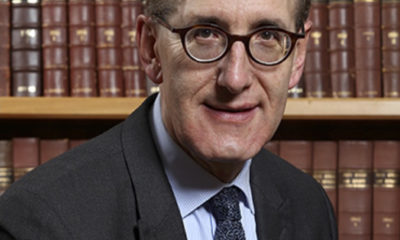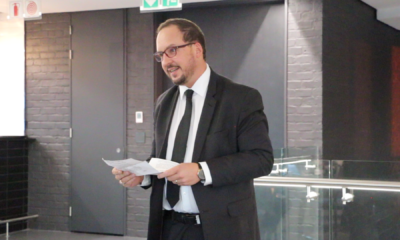
OpEds

Barbarossa and barbarism in the Soviet invasion
Exactly 80 years ago, on 22 June 1941, the Nazis launched Operation Barbarossa, a savage assault on the Soviet Union. Named after the Holy Roman Emperor and German crusader of the twelfth century, it was the largest invading force that had ever been assembled, numbering nearly 3.6 million men, 3 600 tanks, 600 000 motor vehicles, 7 000 artillery pieces, and 2 500 aircraft.
The assault was in flagrant violation of the earlier German-Soviet non-aggression pact of 23 August 1939, and ensured that the war would now be fought in the East as well as the West. Brutal and murderous, Operation Barbarossa arguably prepared the way for the Final Solution.
Although some observers maintain that Operation Barbarossa was a pre-emptive strike designed to cripple an anticipated Soviet offensive, this wasn’t the case. In mid-1941, the Soviet forces were far from ready. Yet, Stalin sensed that the Third Reich would sooner or later turn on the Soviet Union. “War with Germany is inevitable,” he told graduating military cadets in Moscow on 5 May 1941. Nonetheless, he warned his generals against any provocative action, hoping that stepping up the delivery of supplies to Germany in terms of trade agreements would delay German aggression.
Stalin was wrong. Plans for war had already begun in earnest in December 1940. Hitler wished to destroy the Soviet Army in Western Russia in preparation for a broader struggle against Britain and the United States, while at the same time eliminating the “Judeo-Bolshevik” threat.
German preparations for the attack continued throughout the early months of 1941. On 6 June, the infamous “commissar order” was issued whereby Bolshevik commissars, Communist intelligentsia, and Communist Party functionaries were to be identified during the operation and murdered. Six days later, troops were issued further guidelines demanding “ruthless and energetic action against Bolshevik agitators, irregulars, saboteurs, and Jews, and total eradication of any active or passive resistance”.
By the evening of 21 June 1941, about 10% of Germany’s adult male population – assisted by more than half a million Romanians, Finns, Italians, Hungarians, and Slovakians – were awaiting orders to attack. Just after 03:00 on 22 June, a massive artillery barrage on three fronts shattered the silence, followed by the advance of 17 panzer and 14 motorised divisions in the direction of Leningrad, Moscow, and Kiev.
By late morning of that same day, the Luftwaffe had destroyed 890 Soviet aircraft, mostly caught by surprise on the ground. “Stalin had never had so great a shock in his life,” wrote Soviet historian Dmitri Volkogonov. More than three million soldiers and 3 000 tanks attacked the Soviet Union.
The pace of the advance was spectacular. Troops marched up to 50km a day, and sometimes even more. Barbarism ensued. Soviet political commissars were shot on sight, and tens of thousands of prisoners were killed by firing squad in German concentration camps. By the end of October, more than 300 000 Red Army prisoners had died.
For Jews, Operation Barbarossa turned into a war of racial extermination. Deportation plans – still on the table in early June – rapidly gave way to a Final Solution. In the euphoria of early victory, a Judenrein (Jew-free) “Garden of Eden” in the East was anticipated. “The physical extermination of all European Jewry,” writes Christopher Browning, “had become a top Nazi priority.”
From the very start of the advance, the Einsatzgruppen, Nazi Germany’s motorised killing squads, slaughtered thousands of Jews in the towns and villages of the Baltic region. “What the Führer prophesied is now taking place,” wrote propaganda Minister Joseph Goebbels on 11 August 1941.
Years of unrelenting Nazi racist propaganda and special ideological training for the SS security task forces had dehumanised the Jew. Even the Wehrmacht was involved in terrible atrocities against hapless civilians, whose only crime was to be born Jewish. Mass murders and pogroms took place in public, often reported upon and even photographed. At Babi-Yar outside Kiev, 33 771 Jews including women and children were executed on the last two days of September 1941. The “war against the Jews” had begun in earnest.
In the autumn of 1941, Hitler’s plans to deport Europe’s Jews to “the East” after a victorious war against Russia were changed: deportation could begin before victory. That decision, writes Hitler’s most definitive biographer, Ian Kershaw, “was a fateful one”, bringing “the ‘final solution of the Jewish question’ throughout the whole of Europe a massive step closer”.
For the immense number of European Jews now targeted, new and more efficient killing techniques were needed. The use of poison gas was now considered a viable option. In the first week of December 1941, the first extermination unit began operations in the Polish village of Chelmno through the use of exhaust fumes in mobile gas vans.
Only days before Chelmno became operative as a killing centre, Reinhard Heydrich, the head of the Reich Main Security Office, sent out invitations to several state secretaries and selected SS representatives to attend a conference at Wannsee outside Berlin on 9 December. The purpose was to orchestrate coherent plans to rid Europe of its Jews. Because of the attack on Pearl Harbour, the meeting was postponed to 20 January 1942.
In less than one and a half hours, the participants at Wannsee had agreed on plans to expedite the annihilation of European Jewry. According to eyewitness testimony, a satisfied Heydrich enjoyed a glass of celebratory cognac, looking relaxed at the absence of resistance and awkward questions.
While the deliberations were taking place, another death camp at Belzec was under construction, and the first gas chamber at Birkenau was being prepared for its odious use. Over the next three and a half years, five million more Jews, including a million children, would be killed in an orgy of mass murder and industrialised killing – all this in spite of the Red Army having turned the tide against the Nazi war machine by 1943, beginning with victory at Stalingrad and the retaking of Kursk. By October 1944, the Red Army had marched into East Prussia.
The assault on the Soviet Union had failed. But it wrought havoc and death for European Jewry and many others. The precise relationship between Operation Barbarossa and the Holocaust has generated decades of debate. Some scholars argue that Hitler wanted initially only to deport Jews from German-controlled territory but that the advance into the Soviet Union – and for some the failure of that advance – presented new challenges and options. For some scholars, however, the war was a mere cover for long-planned murder: war and the annihilation of the Jews were intimately connected.
These debates have now largely subsided. It’s impossible to know, says historian Omer Bartov, “whether the Third Reich would have sooner or later pursued a similar genocidal policy had it not invaded the Soviet Union, but the actual timing of the Final Solution, as well as the logistical, geographical, and psychological context within which the war in Russia was conducted leave little doubt as to the close ties between Barbarossa and the regime’s extermination policies”.
- Milton Shain is emeritus professor of historical studies at the University of Cape Town.











Colin Romain
June 24, 2021 at 1:50 pm
Brialliant piece by Dr Shain.
A worthy scholar as always